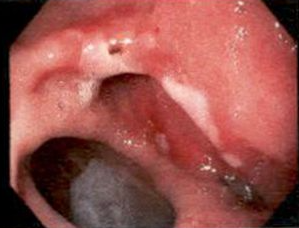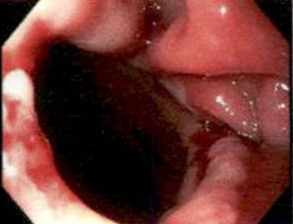Monday Poster Session
Category: Colon
P2537 - Reflux Colitis: A Rare Complication Following Colonic Interposition
Monday, October 27, 2025
10:30 AM - 4:00 PM PDT
Location: Exhibit Hall

Sudiksha Veerareddy, MD (she/her/hers)
Medical City Healthcare
Arlington, TX
Presenting Author(s)
Sudiksha Veerareddy, MD1, Jilpa Shah, DO1, Olufemi E. Osikoya, MD2, Gregory Brennan, MD3
1Medical City Healthcare, Arlington, TX; 2Medical City Arlington, Arlington, TX; 3GI Alliance, Mansfield, TX
Introduction: Colonic interposition surgery involves using a section of colon as a conduit between the esophagus and stomach. This unique post-surgical anatomy may lead to rare complications. Here, we present a case of “reflux colitis,” a term found in the literature back in the 1980’s, which is worth revisiting for today’s gastroenterologists.
Case Description/
Methods: A 40-year-old man with a history of congenital tracheoesophageal fistula now status post colonic interposition was referred for evaluation of unexplained iron deficiency anemia. The patient reported long standing symptoms of heartburn and regurgitation without any overt GI bleeding. Laboratory studies revealed iron deficiency with a serum iron level of 34 µg/dL and ferritin of 30 ng/mL. Eesophagogastroduodenoscopy (EGD) revealed circumferential ulceration at the colo-gastric anastomosis. There were no other structural abnormalities on examination. These findings were consistent with "reflux colitis." See IMAGES 1 and 2. The patient was started on omeprazole 40 mg PO twice daily. Both his symptoms and iron studies improved on follow up.
Discussion: Reflux colitis is a rare complication of colonic interposition surgery. Colonic interposition is used for esophageal reconstruction. Indications for colonic interposition include esophageal malignancy and severe structural diseases such as tracheoesophageal fistulas or caustic injuries. The colon was first used as an esophageal bypass conduit in 1911. Both the left and right colon segments can be used. Post operative complications such as ischemia, stricture, leak, fistula and abscess can involve the remaining esophagus, interposed colon, or the stomach. In the colon, peptic ulcers and reflux colitis have been reported. Strictures commonly involve the colon anastomosis. As opposed to reflux esophagitis, which is common, reports of reflux colitis in the literature are rare and the incidence is not well defined. Because of the unique post operative anatomy, gastroenterologist should be aware of reflux colitis as a possible colonic mucosa complication following colonic interposition. In our case, omeprazole therapy was effective.

Figure: IMAGE 1. Reflux colitis at the colo-gastric anastomosis.

Figure: IMAGE 2. Reflux colitis at the colo-gastric anastomosis with > 75% circumferential involvement.
Disclosures:
Sudiksha Veerareddy indicated no relevant financial relationships.
Jilpa Shah indicated no relevant financial relationships.
Olufemi Osikoya indicated no relevant financial relationships.
Gregory Brennan indicated no relevant financial relationships.
Sudiksha Veerareddy, MD1, Jilpa Shah, DO1, Olufemi E. Osikoya, MD2, Gregory Brennan, MD3. P2537 - Reflux Colitis: A Rare Complication Following Colonic Interposition, ACG 2025 Annual Scientific Meeting Abstracts. Phoenix, AZ: American College of Gastroenterology.
1Medical City Healthcare, Arlington, TX; 2Medical City Arlington, Arlington, TX; 3GI Alliance, Mansfield, TX
Introduction: Colonic interposition surgery involves using a section of colon as a conduit between the esophagus and stomach. This unique post-surgical anatomy may lead to rare complications. Here, we present a case of “reflux colitis,” a term found in the literature back in the 1980’s, which is worth revisiting for today’s gastroenterologists.
Case Description/
Methods: A 40-year-old man with a history of congenital tracheoesophageal fistula now status post colonic interposition was referred for evaluation of unexplained iron deficiency anemia. The patient reported long standing symptoms of heartburn and regurgitation without any overt GI bleeding. Laboratory studies revealed iron deficiency with a serum iron level of 34 µg/dL and ferritin of 30 ng/mL. Eesophagogastroduodenoscopy (EGD) revealed circumferential ulceration at the colo-gastric anastomosis. There were no other structural abnormalities on examination. These findings were consistent with "reflux colitis." See IMAGES 1 and 2. The patient was started on omeprazole 40 mg PO twice daily. Both his symptoms and iron studies improved on follow up.
Discussion: Reflux colitis is a rare complication of colonic interposition surgery. Colonic interposition is used for esophageal reconstruction. Indications for colonic interposition include esophageal malignancy and severe structural diseases such as tracheoesophageal fistulas or caustic injuries. The colon was first used as an esophageal bypass conduit in 1911. Both the left and right colon segments can be used. Post operative complications such as ischemia, stricture, leak, fistula and abscess can involve the remaining esophagus, interposed colon, or the stomach. In the colon, peptic ulcers and reflux colitis have been reported. Strictures commonly involve the colon anastomosis. As opposed to reflux esophagitis, which is common, reports of reflux colitis in the literature are rare and the incidence is not well defined. Because of the unique post operative anatomy, gastroenterologist should be aware of reflux colitis as a possible colonic mucosa complication following colonic interposition. In our case, omeprazole therapy was effective.

Figure: IMAGE 1. Reflux colitis at the colo-gastric anastomosis.

Figure: IMAGE 2. Reflux colitis at the colo-gastric anastomosis with > 75% circumferential involvement.
Disclosures:
Sudiksha Veerareddy indicated no relevant financial relationships.
Jilpa Shah indicated no relevant financial relationships.
Olufemi Osikoya indicated no relevant financial relationships.
Gregory Brennan indicated no relevant financial relationships.
Sudiksha Veerareddy, MD1, Jilpa Shah, DO1, Olufemi E. Osikoya, MD2, Gregory Brennan, MD3. P2537 - Reflux Colitis: A Rare Complication Following Colonic Interposition, ACG 2025 Annual Scientific Meeting Abstracts. Phoenix, AZ: American College of Gastroenterology.
